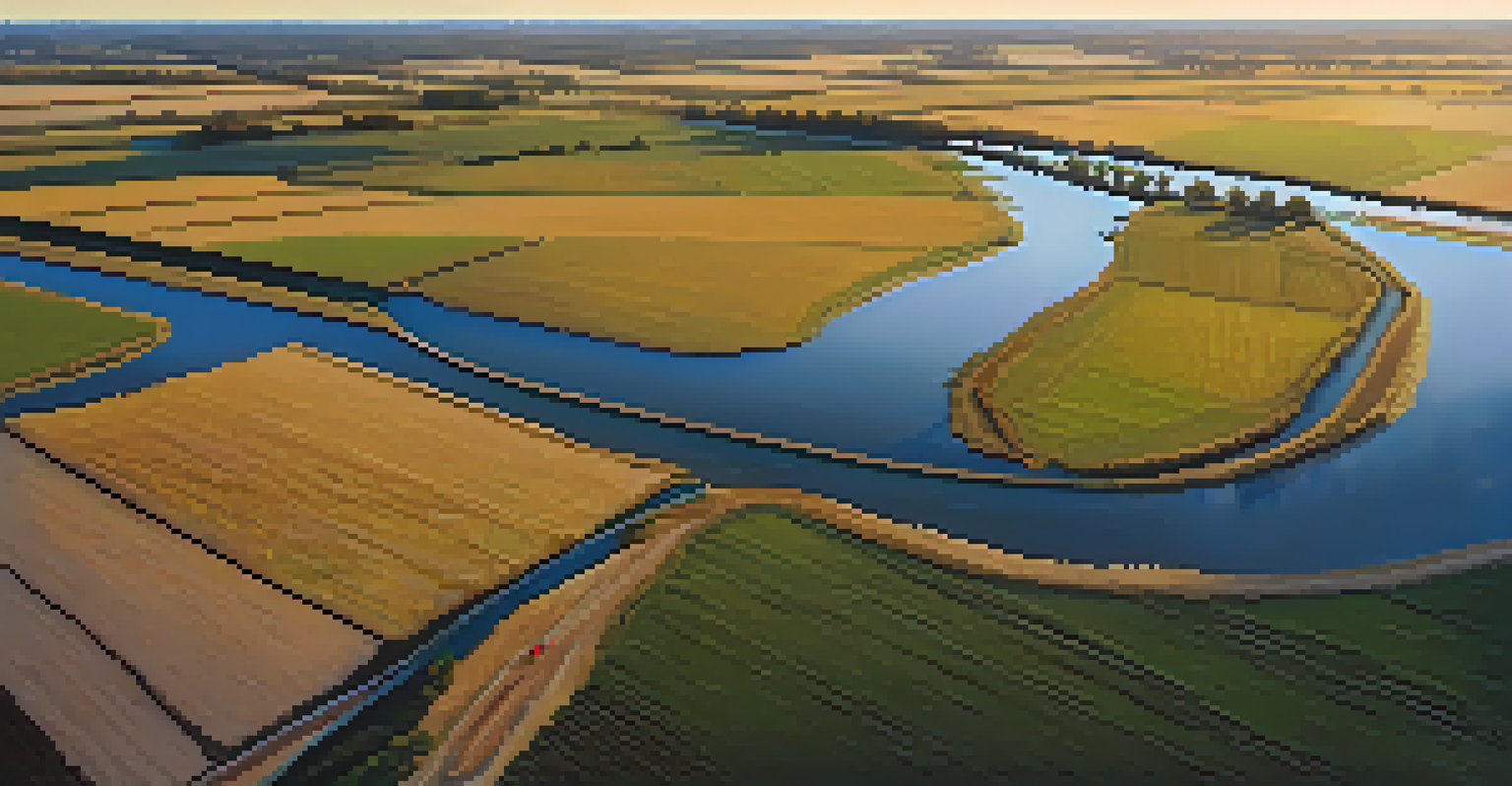The Role of Rivers in Shaping Texas's Geography

Understanding Texas's River Systems and Their Importance
Texas is home to a vast network of rivers that play a crucial role in its geography. From the mighty Rio Grande to the winding Brazos, these waterways shape the land and influence local ecosystems. Rivers not only provide essential water resources but also serve as natural boundaries and habitats for a diverse range of wildlife.
Rivers are the veins of our planet, flowing with the lifeblood that nourishes all forms of life.
Each river system in Texas has its own unique characteristics and history, contributing to the state's rich cultural tapestry. For instance, the Rio Grande has long been a vital source of water for agriculture and a critical border between the U.S. and Mexico. Understanding these rivers helps us appreciate their significance in shaping both the physical and cultural landscapes of Texas.
Moreover, rivers have historically served as vital transportation routes, linking communities and fostering trade. As we delve deeper into Texas's geography, it becomes clear that these waterways are more than mere lines on a map—they are lifelines that sustain both nature and human activity.
The Geological Forces Behind Texas's River Formation
The formation of Texas's rivers can be traced back millions of years to geological processes that shaped the land. Erosion, sedimentation, and tectonic activities have all contributed to the creation of river valleys and basins we see today. For example, the Colorado River's winding path through Central Texas is a result of these dynamic geological forces.

As the land evolved, rivers carved their way through rock and soil, creating unique landscapes. The gentle slopes of the Hill Country and the dramatic canyons of the Panhandle are direct results of these ancient processes. This interplay between geology and hydrology is crucial for understanding the current geography of Texas.
Texas Rivers Shape Local Ecosystems
Texas's rivers are vital for local ecosystems, providing habitats, influencing climate, and supporting biodiversity.
In essence, rivers act as both sculptors and historians, telling the story of the land's transformation over time. Their meandering courses reveal the narrative of geological change, making them a fascinating subject of study for both geologists and nature enthusiasts alike.
How Rivers Influence Texas's Climate and Ecosystems
Rivers play a pivotal role in shaping the climate of Texas, influencing precipitation patterns and local weather conditions. Their presence can moderate temperatures and create microclimates, which in turn support diverse ecosystems. For instance, the lush riparian zones along rivers provide essential habitats for various plant and animal species.
The river has a strong voice, and it speaks to those who take the time to listen.
These ecosystems are not only vital for wildlife but also contribute to the overall health of the environment. They help filter pollutants, control flooding, and maintain water quality. By nurturing such biodiversity, rivers sustain the ecological balance that is crucial for both human and environmental well-being.
Additionally, the interplay of rivers and climate shapes agricultural practices across the state. Farmers often rely on river systems for irrigation, making these waterways indispensable for Texas's economy and food production.
Cultural Significance of Rivers in Texas History
Throughout history, rivers have significantly influenced the cultural development of Texas. Indigenous peoples relied on these waterways for sustenance, transportation, and trade long before European settlers arrived. The rich cultural heritage surrounding rivers is still evident today, with numerous festivals and traditions celebrating their importance.
As settlers moved into Texas, rivers became focal points for establishing communities and economies. Towns sprang up along riverbanks, leading to the development of trade routes and social networks. The history of Texas is intricately intertwined with the stories of its rivers, from the early days of exploration to modern times.
Cultural Importance of Texas Rivers
Throughout history, rivers have been central to Texas's cultural development, serving as lifelines for indigenous communities and settlers alike.
In contemporary Texas, rivers continue to inspire art, music, and literature, reflecting their lasting impact on the state's identity. These waterways are not just natural features; they are integral to the story of Texas and its people.
Rivers as Natural Resources and Economic Drivers
The rivers of Texas are vital natural resources that support various economic activities. From agriculture to tourism, these waterways provide essential benefits that drive local economies. Farmers rely on river water for irrigation, while recreational activities such as fishing and kayaking attract visitors from all over.
Moreover, rivers facilitate transportation and shipping, playing a critical role in trade. Ports along the Gulf Coast, fed by rivers, are essential for the import and export of goods, contributing significantly to Texas's economic growth. This multifaceted role of rivers as economic drivers is crucial for understanding their importance in the state.
As communities recognize the value of preserving these water resources, sustainable practices are being implemented to ensure their longevity. Balancing economic development with environmental stewardship is key to maintaining the health of Texas's rivers for future generations.
Challenges Facing Texas Rivers Today
Despite their significance, Texas rivers face numerous challenges that threaten their health and sustainability. Pollution from agricultural runoff, industrial discharges, and urban development can severely impact water quality. These issues not only affect the rivers themselves but also the ecosystems and communities that rely on them.
Additionally, climate change poses a significant threat to Texas's river systems. Altered rainfall patterns and increased temperatures can lead to droughts or flooding, disrupting the delicate balance of these ecosystems. As we witness these changes, it's essential to understand how human activity and climate factors intertwine to impact our rivers.
Challenges Threatening Texas Rivers
Texas rivers face significant challenges from pollution and climate change, necessitating collective efforts for their protection and sustainability.
Addressing these challenges requires collective action from communities, policymakers, and environmental advocates. By raising awareness and promoting sustainable practices, we can work together to protect Texas's rivers for future generations.
Conservation Efforts to Protect Texas Rivers
In response to the challenges facing Texas rivers, various conservation efforts are being implemented to protect these vital resources. Local organizations and government agencies are working together to restore habitats, improve water quality, and promote sustainable land management practices. These initiatives aim to create a healthier environment for both wildlife and human populations.
Community involvement is also crucial in these conservation efforts. Educational programs and volunteer opportunities encourage residents to engage with their local rivers and understand their importance. By fostering a sense of stewardship, communities can contribute to the long-term health of these waterways.

Ultimately, successful conservation requires a collaborative approach that involves individuals, organizations, and policymakers. By prioritizing the health of Texas's rivers, we can ensure these natural treasures continue to enrich our landscapes and lives for generations to come.